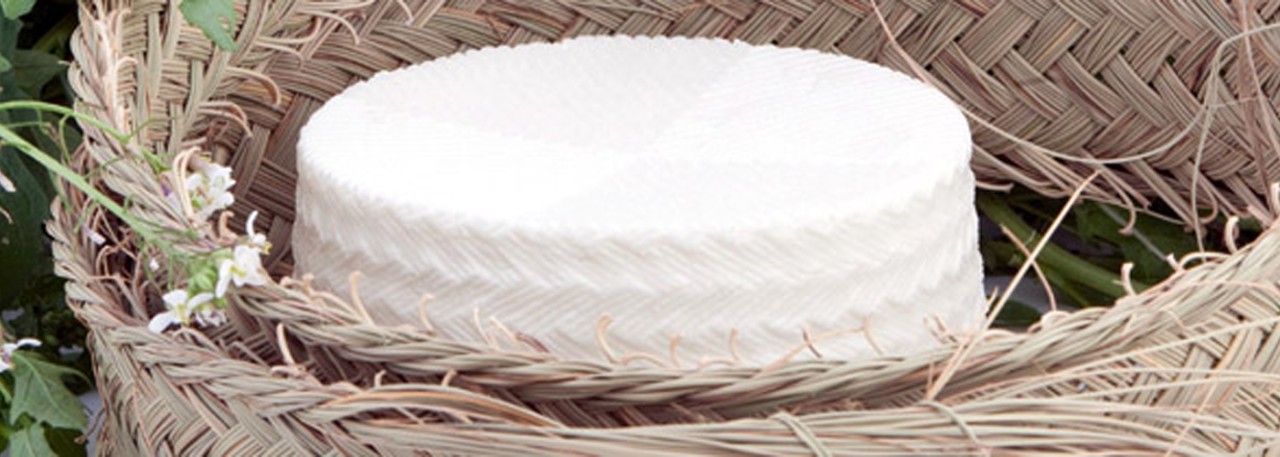.png.transform/rendition-xs/image_image%20(1).png)
Queso de Murcia PDO
Pressed, washed, uncooked cheese made from Murcian goats’ milk and cured for a minimum of 45 days for large cheeses and 30 days for small ones. Macerated in red wine during ripening to give the rind the characteristic color and aroma.
Tasting notes
-Queso de Murcia Fresco:
The aroma and taste are reminiscent of goats’ milk cream or yoghurt, with a touch of salt, especially in the outside parts. The texture is soft, consistent, elastic and wet.
-Queso de Murcia Curado:
A mild smell of hay and nuts and a flavor of goats’ milk and sweet nuts or, in riper cheeses, of toasted nuts. The texture is compact, firm and slightly elastic.
Other notes
-Queso de Murcia Fresco:
Cylindrical, weighing either about 300 g (11 oz), and measuring 5-8 cm (2-3”) high and 7-9 cm (2½-3½”) in diameter, or 1-2 kgs (2 lb 2oz - 4 lb 4 oz ), and measuring 8-12 cm (3-4½”) high and 12-18 cm (4½-7”) in diameter. The rind is practically non-existent, and bears the typical marks of the esparto grass straps and the boards of traditional presses. The paste is bright white, lightly pressed and uncooked, compact when cut and has almost no eyes.
-Queso de Murcia Curado:
Cylindrical, 7-9 cm (2½-3½”) high, 12-18 cm (4½-7”) in diameter, and weighing 1-2 kgs (2 lb 2oz - 4 lb 4 oz). The rind is waxy to ochre in color, smooth and unmarked. The paste is waxy yellow, pressed and uncooked, with just a few small holes.
Production / Processing method
Milk yield is high in Murcian goats, and many flocks, being milked just once a day and producing one kid a year, give over 600 kg of milk per lactation. The milk has average fat, protein and dry matter content, making it excellent for cheese making.
After manual or machine milking, the milk is filtered and soured using animal rennet or other authorized starters. This process takes place at 32-35ºC (89-95ºF) for 30-45 minutes for fresh cheeses, and at 30-34ºC (86-93ºF) for 40-60 minutes for ripe cheeses.
The next stage is to cut the curds until they form grains 10 mm (2/5”)in diameter for the fresh cheese and 5 mm (1/5”) for ripe cheese. The mixture is then re-heated to 3-5ºC (37-41ºF) above the coagulation temperature.
Then the grains are worked very lightly to form a soft consistency for the fresh cheese and more energetically until hard for the ripe cheese.
The curds are then pressed into molds bearing the traditional markings of the esparto grass straps and the press boards or, for ripe cheeses, plain molds. In the former case, the cheese is pressed briefly and lightly and, in the latter, for 2-4 hours until the right pH is reached.
Salting is by immersion in brine for a maximum of ten hours and at a maximum saline concentration of 16º Beaumé for fresh cheese, and a maximum of 20 hours at a maximum saline concentration of 20º Beaumé for ripe cheese. Finally, the fresh cheeses are drained and chilled at no more than 4ºC (39ºF). They are not ripened at all.Ripe cheeses are matured for a minimum of 60 days.
Geography / Relief and climate
The production area has very varied topography, and the different landscapes each have their own climatic conditions. The climate is sub-tropical Mediterranean, with scarce rainfall, and high temperatures. The soils are mostly saline, with little moisture content. The soils tend to be saline and dry, so the vegetation is mostly scrub. There are many Lamiaceae and Cistaceae, these being the main source of food for goats in dry, mountainous areas.
Regulatory Council
Consejo Regulador de las DOP Queso de Murcia y Queso de Murcia al Vino
Pl. de la Alcorera, 3 - 2ª Plta. - Ed. Sociocultural Roque Baños
30520 Jumilla
Murcia
Tel: (+34) 679 162 813
quesosdemurcia@quesosdemurcia.com
www.quesosdemurcia.com
Sources:
- Spanish Ministry of Agriculture
The texture in the fresh cheeses is soft, consistent, elastic and wet, and in ripe cheeses is compact, firm and slightly elastic.


- Queso de Murcia 1
- Queso de Murcia 2

Jumilla (Murcia)
